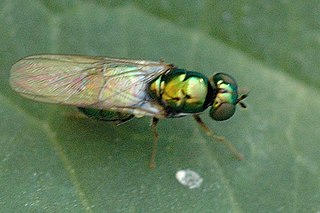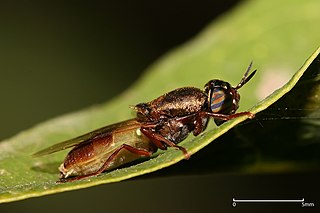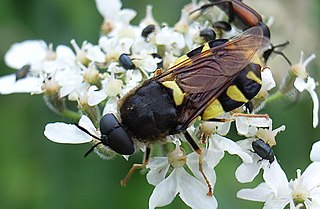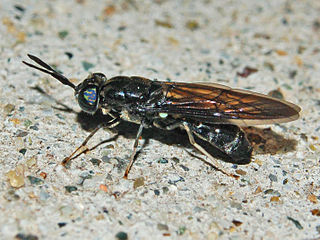
The soldier flies are a family of flies. The family contains over 2,700 species in over 380 extant genera worldwide. Larvae are found in a wide array of locations, mostly in wetlands, damp places in soil, sod, under bark, in animal excrement, and in decaying organic matter. Adults are found near larval habitats. They are diverse in size and shape, though they commonly are partly or wholly metallic green, or somewhat wasplike mimics, marked with black and yellow or green and sometimes metallic. They are often rather inactive flies which typically rest with their wings placed one above the other over the abdomen.

Microchrysa is a genus of soldierfly belonging to the family Stratiomyidae. There has been some confusion with the synonym Chrysomyia of Macquart, 1834, causing some members of the genus Chrysomya of Robineau-Desvoidy, 1830 to be placed erroneously in this genus.

Odontomyia is a genus of soldier flies in the family Stratiomyidae.

Chloromyia formosa is a species of soldier flies belonging to the family Stratiomyidae. Another name for it is Broad centurion.

Stratiomys is a genus of flies in the family Stratiomyidae.

Stratiomyini is a tribe of flies in the family Stratiomyidae.

Oxycera is a genus of flies in the family Stratiomyidae.

Nemotelus is a genus of soldier flies in the family Stratiomyidae. Nemotelus is known from the Nearctic, Afrotropical and the Palaearctic regions.

Stratiomyinae is a subfamily of flies in the family Stratiomyidae.

Clitellariinae is a subfamily of flies in the family Stratiomyidae.

Pachygastrinae is a subfamily of flies in the family Stratiomyidae.

Hermetia is a genus of flies of the family Stratiomyidae.

Cyphomyia is a genus of flies in the subfamily Clitellariinae.

Psellidotus is a genus of flies in the family Stratiomyidae.
Chrysochlora is a genus of flies in the family Stratiomyidae.
Lasiopa is a genus of flies in the family Stratiomyidae.
Artemita is a genus of flies in the family Stratiomyidae.
Raphiocerinae is a subfamily of flies in the family Stratiomyidae.
Raphiocerini is a tribe of flies in the family Stratiomyidae.













